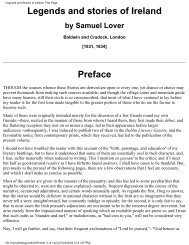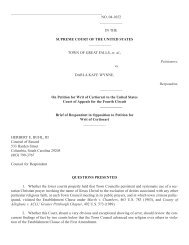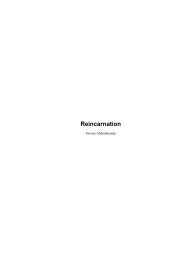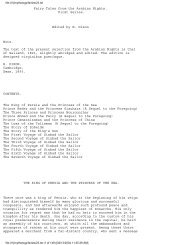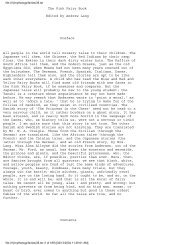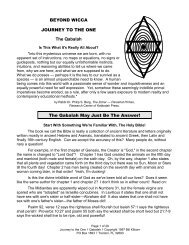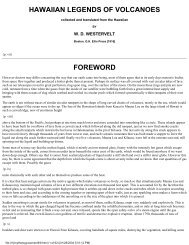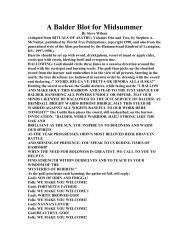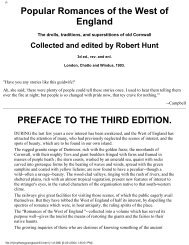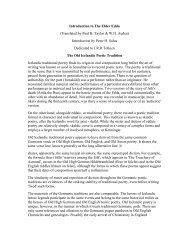Irish Druids And Old Irish Religions PREFACE CONTENTS
Irish Druids And Old Irish Religions PREFACE CONTENTS
Irish Druids And Old Irish Religions PREFACE CONTENTS
You also want an ePaper? Increase the reach of your titles
YUMPU automatically turns print PDFs into web optimized ePapers that Google loves.
word Sibbol as "a name by which the <strong>Irish</strong>, as well as almost all other nations, designated and worshipped Cybele;" sibola, an ear of corn,<br />
being a symbol of Ceres and Cybele of the Phœnicians. Several supposed Phœnician relics, especially swords, have been discovered in<br />
Ireland.<br />
The Gaulish Belenus was known over these Islands. In his temples at Bayeux and at Bath there were images of the Solar god. He was<br />
adored, too, at Mont St. Michel. A remnant of his worship is seen in the custom of maids washing their faces in May-morn dew, and then<br />
mounting<br />
p. 126<br />
a hill to see the sunrise. According to Schedius, the word may be rendered 2 + 8 + 30 + 5 + 50 + 70 + 200 or 365, the period in days of the<br />
sun's annual round. The solar Hercules was represented in <strong>Irish</strong> by Ogmian or Ogham. The god of light was ever god of the Heavens.<br />
Belenus was Belus or Belis, from belos, an arrow, or ray, and therefore a form of Apollo. As Apollo-Belinus, he was the young Sun,<br />
armed with arrows or rays, and was exhibited as a young man without beard, and rays round his head. As Apollo-Abelios, he was the old<br />
or winter sun, having no rays. The Breton god was Beletucadrus--Mars and Apollo being identical. The votive altar at St. Lizier bears the<br />
names of Minerva and Belisana. Baron Chaudruc-de-Crazannes, writing upon Belisana, goddess of the Gauls, observes that Cæsar "had<br />
found in Esus, Taranis, Teutates, Camulus, Belisana, an identity with Jupiter, Mercury, Apollo, Mars, and Minerva, of Greeks and<br />
Romans." Belisana, without lance or shield, was called the Queen of Arrows, i. e. the solar rays. She was represented as thinking<br />
profoundly.<br />
Samhan, literally servant, is derived from Sam, the sun; so, samh-an, like the sun. As the <strong>Irish</strong> Pluto, he is guardian of the Dead. As such,<br />
he would receive the prayers for souls on Hallow Eve. The Arab schams is the sun. Cearas, god of fire, has a feminine equivalent in<br />
Ceara, goddess of Nature. As the horse was a symbol of the sun, we are not surprised to see it associated with the god Cunobelin of Gaul,<br />
who had the sun's face, with locks of hair. The Gaulish Cernunnos appeared as an old man with horns on his head.<br />
Le Blanc, in Etude sur le Symbolisme Druidique, asserts that the name of Bal-Sab proves that Bâl, Bel, or Beal is the same as the <strong>Irish</strong><br />
Samhan. Bâl is the personification. of the sacred fire become visible. The year, the work of<br />
p. 127<br />
Samhan, the Sun, was known as the Harmony of Beal. Samhan, adds Le Blanc, "was that idol which the King of Ireland adored after the<br />
name of head of all the gods." In the Psalms we read, "They join themselves to Baal-Peor, and eat the sacrifice of the dead." This was true<br />
of many ancient countries, and may; perhaps, be applied to Ireland.<br />
A Hymn to Apollo, appearing in the ably conducted Stonyhurst Magazine, is so beautiful, and so truly descriptive of the sun and fire<br />
worship of ancient Erin, that a verse of it may be transcribed:--<br />
"Pile up the altar with faggots afresh,<br />
The head be off severed--strew wheat and rye,<br />
Pouring libations of wine on the flesh,<br />
That odorous incense ascend the sky!<br />
Ward against evil,<br />
Guard of the byre--<br />
Glorious sun-god--<br />
Prince of the lyre!<br />
Olympus compelling<br />
With harmonious swelling--<br />
Apollo aeidon!<br />
Worshipped with fire!"<br />
There was an <strong>Irish</strong> fish god, associated with caves and storms, with the attributes of Dagon in the land of the Philistines. Neith, a god of<br />
war, had two wives, Nemain and Fea; these were also styled goddesses of war. The Book of Leinster names Brian, Tuchar, and Sucharba<br />
as gods of the Tuaths. The <strong>Irish</strong> Badb is but the Gaulish Badna, and yet not a goddess of war. Deuc or Ducius was known to St. Austin as<br />
"a libidinous demon." Aou was another Celtic god.<br />
Camulus, the Gaulish Mercury, whose image was on the Puy de Dome, was the <strong>Irish</strong> Cumall, father of the mythical Finn, and said to be<br />
the same as the Welsh Gwyn, son of Nûd. The <strong>Irish</strong> Toth was probably a copy of Thoth, or the Gaulish Teut, god of war. Canobalinos, the<br />
Welsh<br />
p. 128<br />
Conbelin, was adored in both isles. Decete is named in Devon, Anglesey, and South-west Ireland.<br />
Dormer Supposed the deities were first of place, then of peoples. Rhys saw minor gods as genii locorum and asked what race it was that<br />
gave the Celtic lands its population of spirits. He regarded the mass of divinities as "very possibly creations of the people here long before<br />
the Celts." The non-Aryan mythology had doubtless great influence on the religion of the Goiedels.<br />
When St. Patrick tried conversion Upon the King's daughters, Eithne and Finola, they inquired if his god lived in the hills, valleys,<br />
file:///I|/mythology/witchcraft/8/8.html (46 of 114) [02/05/2004 8:38:14 AM]



